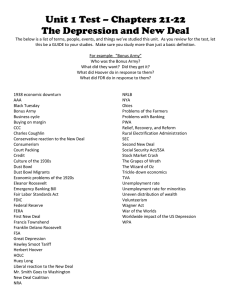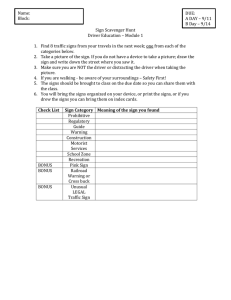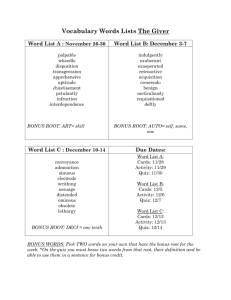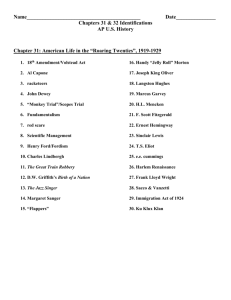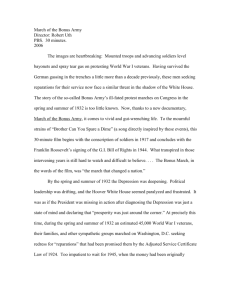Bonus Army
advertisement
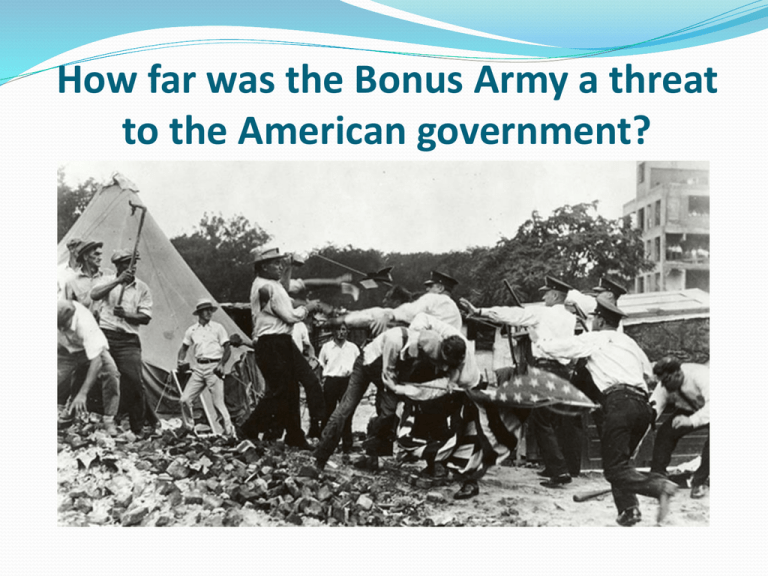
How far was the Bonus Army a threat to the American government? Learning objective – to be able to assess the threat of the Bonus Army and whether the US government’s reaction was justified. I can describe what the Bonus Army and the US government did. Grade D I can explain the causes and impact of the Bonus Army episode. Grade B I can explain and assess using sources the impact of the Bonus Army. Grade A Starter This word cloud summarises the content of the story Bonus Army. In pairs, find the 14 terms in the word cloud and using the PowerPoint and the sheet given to you, list the 15 terms and, for each term, write their relevance to the Bonus Army story in two sentences. Terms Bonus Army Hoover Bonus Veterans Anacostia Flats Marches Protest Pension Great Depression Bonus City MacArthur Out of touch Revolution Fighting Was there growing public disorder? By 1931, there were no signs that the Great Depression was abating. Unemployment was still rising and wages were continuing to fall. Many felt that the President was not doing enough to help the people. Some decided to protest. Farmers in Iowa fought government officials who tried to evict farmers who fell behind with mortgage repayments. In Arkansas, starving farmers stormed a shopping centre and seized food. What was the Bonus Army? The Bonus Army was made up of veteran US soldiers who had served during the First World War. There were 22,000 men in the Bonus Army, which swelled to 40,000 when including their families. These veterans had fallen on hard times during the Depression. They were due their war pension in 1945 – a bonus of $500 - but wanted it in 1932 to help them survive the Depression. The government refused this request. How did the Bonus Army protest? The Bonus Army decided to march on the American capital – Washington DC – which was relatively untouched by the Great Depression. The Bonus Army then built a Hooverville just outside Washington at Anacostia Flats, called it Bonus City, and said they would stay until the bonus was paid. What was the reaction to the Bonus Army protest? Hoover was furious and publicly called the Bonus Army ‘criminals’ with other government officials labelled them as a ‘rabble’. This was deeply unfair, these people has served in the US Army and had organised the protest with military precision. To pay the bonus early would have cost the government $2.3 billion – money the government did not have to spare. Instead, Congress provided money to transport the protesters home but 5,000 refused to leave. This was despite attempts by the police to forcibly remove them. What was the Battle of Anacostia Flats? Hoover called in the troops to disperse the Bonus Army. General Douglas MacArthur led the troops. He was a notoriously heavyhanded officer and did not shirk from this task. Using cavalry, tanks, machine guns and infantry, the Bonus City was marched upon, cleared and razed to the ground in what was called the Battle of Anacostia Flats. More than 100 people were injured, two people and a baby were killed. What was the impact of the Battle of Anacostia Flats? The handling of the Bonus Army protest showed Hoover as out of touch with the electorate. However, others thought that the Bonus Army protest showed the country on a brink of a revolution which needed putting down. Main task Choose ONE task from the following list to complete – Design a promotional leaflet for Roosevelt’s Presidential campaign of 1932 emphasising Hoover’s handling of the Bonus Army. Write a campaign speech for Hoover justifying his actions. Write three diary entries from a member of the Bonus Army which includes their experience of the campaign and the Battle of Anacostia Flats. Plenary Stick a copy of this visual representation of the Bonus Army into your exercise book. Beside each image write how it can contribute to answering the central question – ‘What was the impact of the protest of the Bonus Army?’
